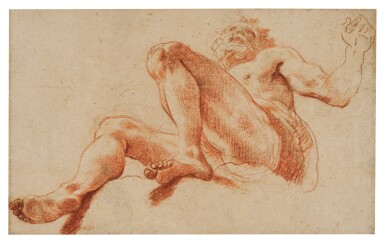From Taddeo to Tiepolo: The Dr. John O’Brien Collection of Old Master Drawings
From Taddeo to Tiepolo: The Dr. John O’Brien Collection of Old Master Drawings

Mattia Preti (Taverna, Calabria 1613 - 1699 Valletta, Malta) Francesco Solimena (Canale di Serino 1657 - 1747 Barra)
Auction Closed
January 27, 09:35 PM GMT
Estimate
20,000 - 30,000 USD
Lot Details
Description
Mattia Preti (Taverna, Calabria 1613 - 1699 Valletta, Malta)
Francesco Solimena (Canale di Serino 1657 - 1747 Barra)
Recto: Reclining Male Nude
Verso: Flying Draped Female Figure with Two Putti
Red chalk heightened with white (recto); red chalk (verso)
197 by 319 mm; 7 3/4 by 12 1/2 in
Private Collection, Milan;
With Mia Weiner, New York, Old Master Drawings, 1988 (Fall), cat. no. 28,
where acquired, 1988
L. Tassoni, Mattia Preti e il senso del disegno, Bergamo 1990, p. 125, reproduced figs. 49,50 (as Mattia Preti, recto and verso);
C. Ippoliti, in AA.VV., Mattia Preti Disegni e colore, Catanzaro 1991, nn. 24, 24a (as Mattia Preti, recto and verso);
E. Corace, Mattia Preti: dal segno al colore, Rome 1995, p. 91, nos. 47-48 (as Mattia Preti, recto and verso), reproduced, p. 253
This rare double-sided sheet is of special interest, being executed by two major artistic personalities: Mattia Preti (recto) and Francesco Solimena (verso). The verso testifies to the strong influence that Preti had, from a very early stage, on the career of the Neapolitan Francesco Solimena and to which the latter would return at different times in the course of his long life.
The recto represents a male figure seated on clouds looking upwards, executed with a vigorous and decisive use of the red chalk, with deep indications of shadows. The drawing must date from the period of a couple of years following the death of Pope Urban VIII, Barberini in 1644, when Preti is not documented in Rome and most probably travelled in the north of Italy and Venice. As various authors have observed, from the second half of the 1640s an unprecedented understanding of theatrical and atmospheric effects becomes apparent in his painted works, due most probably to his exposure to the grandeur of the canvases and frescoes of the leading Venetian artists, especially Paolo Veronese (1528-1588) and Titian (1490-1576).1 Interestingly, the paper that Preti has used for this drawing, with its three crescent moon watermark, is most likely Venetian. The figure must have been drawn for use within a decorative scheme, but does not seem to be connected with any known surviving works, although Preti did include similar figures in the slightly later fresco decorations for the Carmelite church of San Biagio at Modena (1651-2).
The sketch on verso, Flying Draped Female Figure with Two Putti, until now thought to be also the work of Preti, is instead clearly by the Neapolitan master Francesco Solimena. The biographer Bernardo De Dominici, in his life of the artist, not only clearly stressed Solimena's debt to Mattia Preti as a draftsman, but also records that Solimena owned Preti's drawings and valued them enormously. De Dominici even writes that he had himself given to Solimena a number of drawings by Preti from his own collection, some in exchange for Solimena’s own works, others in recognition of Solimena's restoration and embellishment of his collection.2 It is possible that the drawing on the verso dates to around 1700, or slightly later.
The influence of Mattia Preti on Solimena's œuvre can first be detected between the 1680s and the 1690s, not only in his painted works but also in his rapidly evolving graphic style, which was also indebted to the lessons of Lanfranco, Cortona and in particular Giordano. Although only few drawings datable to this period seem to have survived or been identified, they do bear witness to this very important aspect of Solimena's artistic career and formative years.3 In the corpus of surviving drawings by Solimena there is another example where the artist drew on the reverse of a drawing by another master: an academy study on the verso of a sheet by Luca Giordano (1634-1705), in the British Museum.4
1. J.T. Spike, Mattia Preti, Florence 1999, p. 25
2. B. De Dominici, Vite de' pittori, scultori ed architetti napoletani, Naples 1742-1745, ed. 2008 (ed. F. Sricchia Santoro - A. Zezza), p. 1175
3. For example a study for St. James the Great, (private collection), previously attributed to Mattia Preti, but recognized as Solimena by Enrico De Nicola, who connected it to a bozzetto of the same composition (private collection). See C. Romalli, in Francesco Solimena (1657-1747) e le Arti a Napoli, (curated by N. Spinosa), vol. II, Rome 2018, p. 124, D. 20, both reproduced
4. London, British Museum, inv. no. 1996,0928.7; Romalli, op. cit.,vol. II, pp. 172-173, D61, both reproduced
